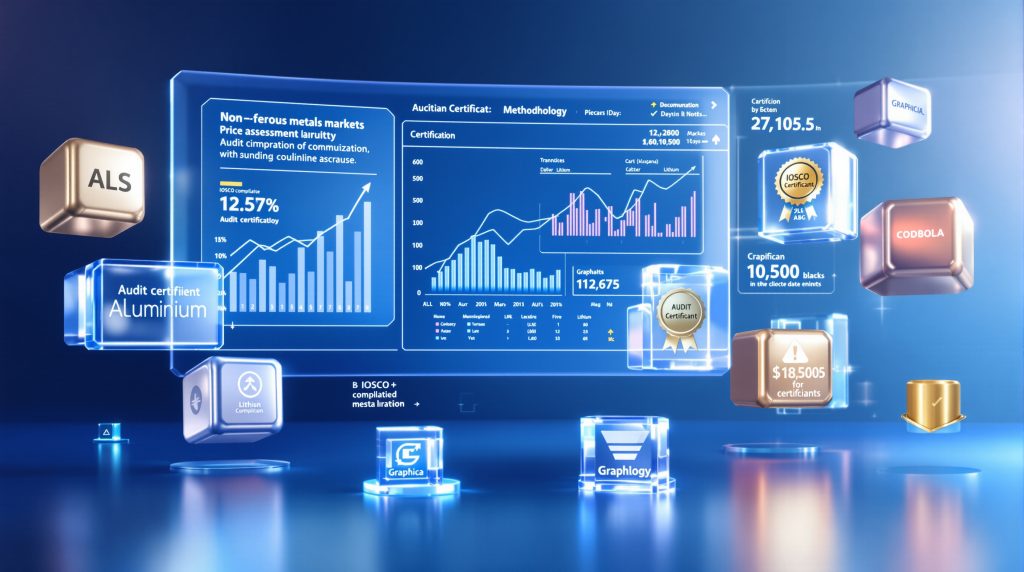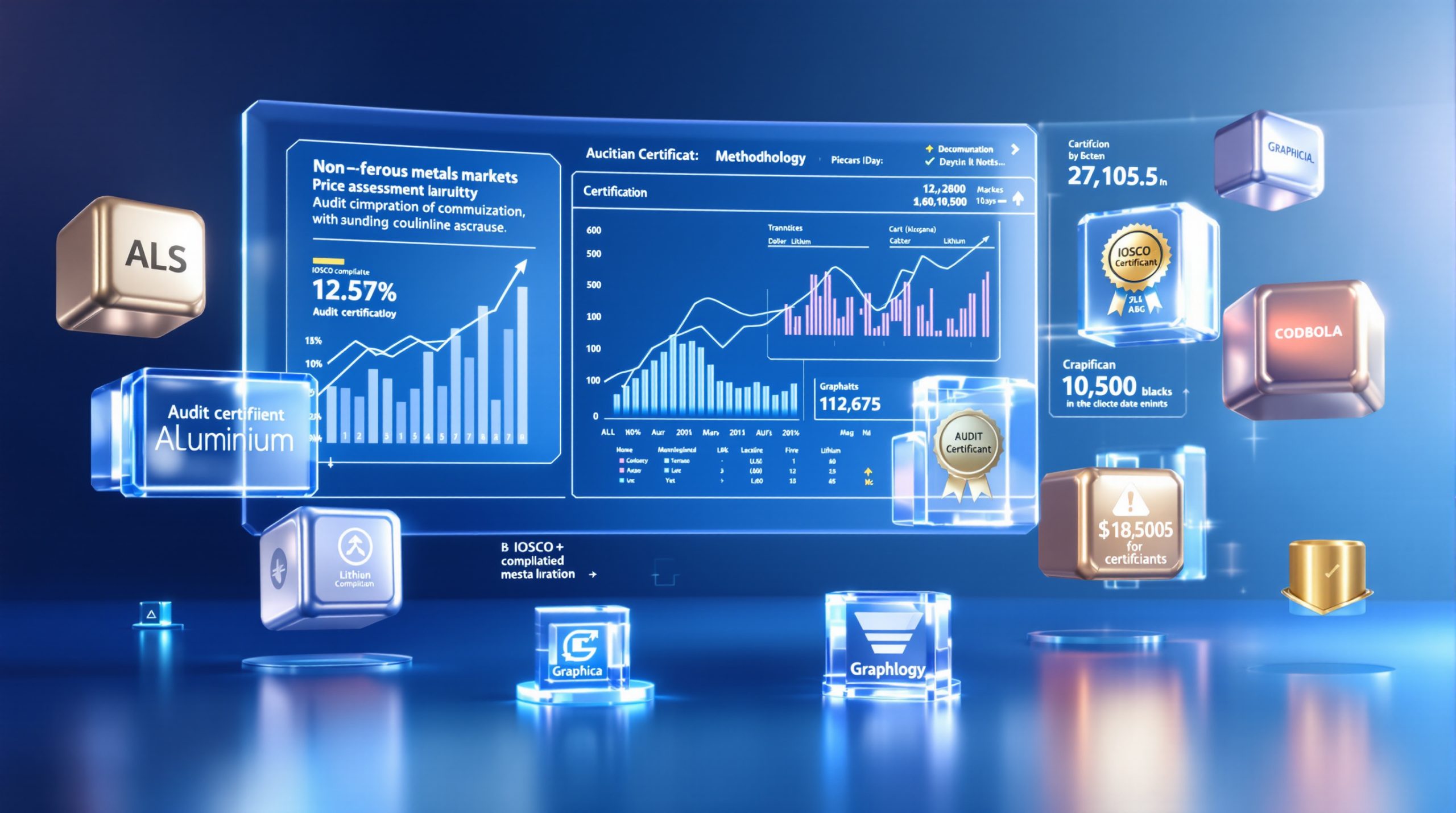Understanding Audited Non-Ferrous Price Assessments: A Comprehensive Guide
The Foundation of Market Transparency
Audited non-ferrous price assessments serve as independent reference points that establish fair value for metals trading in global markets. These assessments differ significantly from non-audited benchmarks through their adherence to rigorous methodological standards and third-party verification processes, providing market participants with reliable pricing information they can confidently use in contracts and risk management strategies.
Price assessments function as the backbone of the metals industry, enabling transparent price discovery in markets where private, bilateral deals remain the norm rather than exchange-traded transactions. For commodities like battery materials, specialty alloys, and regional metal premiums, these assessments often represent the only trusted pricing reference available.
According to the International Organization of Securities Commissions (IOSCO), which represents regulators from over 130 jurisdictions covering 95% of global securities markets, properly administered price assessments are essential for market integrity and efficiency.
The IOSCO Compliance Framework
The IOSCO Principles for Price Reporting Agencies (PRAs), initially published in 2012 for oil markets and later extended to other commodities, established the global standard for price assessment integrity. These principles focus on three core areas: quality and integrity of the price assessment process, methodology transparency, and governance structures that minimize conflicts of interest.
Following the 2008 financial crisis and subsequent concerns about benchmark manipulation, regulatory oversight of commodity price reporting intensified. The European Union's Benchmark Regulation (BMR), implemented in 2018, formalized many IOSCO principles into binding regulations for benchmarks used within EU markets.
Today, approximately 30-40 major PRAs operate globally, with varying degrees of regulatory compliance. Those maintaining IOSCO-audited methodologies submit to annual independent reviews that verify their adherence to these principles.
How Are Non-Ferrous Price Assessments Developed?
Methodology Fundamentals
The development of reliable price assessments begins with systematic data collection from market participants across the supply chain. Price reporting agencies employ specialized reporters who gather transaction data, bids, offers, and market commentary through direct communication with buyers, sellers, and intermediaries.
The most robust methodologies prioritize actual transaction data where available, supplemented by bids, offers, and other market indications when necessary. For instance, a copper price insights might incorporate data from traders, producers, consumers, and brokers to ensure comprehensive market coverage.
Normalization procedures address variations in quality specifications, delivery terms, payment conditions, and other factors that influence price. For battery materials like lithium, specifications are particularly crucial—battery-grade lithium carbonate (99.5% Li₂CO₃) typically commands a premium over technical-grade material (99% Li₂CO₃).
According to industry methodologies, normalized data points must represent standardized specifications. For example, a lithium hydroxide assessment might standardize to 56.5% LiOH minimum content with defined impurity limits.
The Assessment Lifecycle
Price assessments follow disciplined publishing schedules aligned with market trading patterns. Based on industry methodology documents, assessment frequencies typically include:
- Daily assessments: Used for highly liquid markets like aluminum premiums (P1020A) and standard-grade cobalt
- Weekly assessments: Common for battery materials like lithium and graphite, where transaction frequency is lower
- Monthly assessments: Applied to some specialty products with infrequent trading
Each assessment operates within defined submission windows—specific timeframes when market data can be submitted for consideration. These windows ensure that assessments reflect market conditions at a consistent point in time.
Publication protocols include clearly defined procedures for corrections and revisions. Most PRAs distinguish between simple errors requiring immediate correction and material changes that may warrant market notices and explanations.
Which Metals Fall Under Audited Non-Ferrous Assessments?
Base Metals Portfolio
The range of base metals covered by audited non-ferrous price assessments continues to expand as market complexity grows. Leading price reporting agencies maintain dozens of IOSCO-compliant assessments across multiple metal categories.
Aluminum assessments include primary metal premiums, specialty products, and regional variants:
- P1020A premiums across key markets (Japan, Europe, US)
- Extrusion billet premiums for specific regions (Germany, Italy)
- Secondary alloys like DIN226/A380 for European markets and A380.1 for US applications
Copper assessments focus on both refined metal and upstream materials:
- Cathode premiums for major importing regions like China
- Concentrates indices including treatment charges (TC) and refining charges (RC)
Nickel assessments increasingly cover battery supply chain materials:
- Refined nickel premiums across global delivery locations
- Chemical products like nickel sulfate (21-22.5% Ni content) for battery applications
Battery Materials Ecosystem
The electric vehicle revolution has driven explosive growth in battery materials price assessments. These markets typically feature complex quality specifications and regional pricing dynamics.
Lithium pricing encompasses multiple chemical forms and grades:
- Carbonate (99.5% Li₂CO₃) for battery applications
- Hydroxide (56.5% LiOH) for high-nickel cathode production
- Technical and industrial grades with lower purity requirements
- Spodumene concentrate (6% Li₂O) for lithium mining trends and conversion plants
Cobalt assessments span the value chain from metal to chemicals:
- Standard and alloy grade metal for traditional applications
- Cobalt hydroxide with payability linked to metal prices
- Cobalt sulfate (20.5% Co) for battery cathode production
Graphite benchmarks reflect natural flake and processed material:
- Flake graphite (94% C, -100 mesh)
- Spherical graphite (99.95% C, 15 microns) for battery anodes
What Makes a Price Assessment Methodology Trustworthy?
Transparency Requirements
Methodology transparency represents the cornerstone of assessment credibility. IOSCO principles require public documentation of all key aspects of the assessment process.
This documentation must clearly define:
- Product specifications (grade, quality, impurity limits)
- Delivery terms and locations
- Assessment timing and frequency
- Data types considered (transactions, bids, offers)
- Normalization procedures
- Calculation approaches
Leading PRAs publish comprehensive methodology guides detailing these elements. These documents serve as reference points for market participants and provide the framework against which compliance is audited.
Standard quality definitions must be precise and market-relevant. For example, cobalt sulfate assessments typically specify not only cobalt content (20.5%) but also maximum levels of impurities like nickel and manganese that affect battery performance.
Independence and Governance
Robust governance structures ensure assessment integrity by addressing potential conflicts of interest. Key safeguards include:
- Editorial independence from commercial pressure
- Clear separation between price reporting and commercial functions
- Documented approval processes for methodology changes
- Policies governing market participant engagement
Complaint handling procedures provide stakeholders with recourse when assessment processes are questioned. These typically include:
- Formal documentation requirements
- Defined escalation paths
- Resolution timeframes
- External review mechanisms when needed
Record-keeping requirements support auditability by preserving assessment inputs, calculations, and decisions. IOSCO-compliant PRAs maintain detailed audit trails that document market submissions, editor judgments, and publication processes.
How Do External Audits Verify Assessment Integrity?
The Audit Process Explained
Independent audits provide third-party verification that price assessments adhere to stated methodologies and comply with regulatory requirements. While IOSCO principles don't specifically mandate external audits, they have become standard practice for leading PRAs.
Audit processes typically include:
- Review of methodology documentation
- Examination of assessment procedures
- Verification of data handling practices
- Evaluation of quality control mechanisms
- Testing of calculation methodologies
- Review of governance structures
Auditors typically verify that assessment processes match published methodologies by tracing specific assessments from data collection through publication. They examine how PRAs handle challenging situations such as thin liquidity or market disruptions.
Common Audit Findings
Independent audits frequently identify opportunities for methodology enhancement and process improvement. Common recommendations include:
- Strengthening documentation of editor judgments
- Improving procedures for handling outlier data points
- Enhancing transparency around assessment inputs
- Standardizing normalization techniques
- Expanding market participant engagement
These findings drive methodology evolution through a continuous improvement process. Leading PRAs implement recommendations systematically, often consulting with market participants on significant changes.
What Role Do Market Consultations Play?
The Consultation Lifecycle
Market consultations provide a structured mechanism for stakeholder input on assessment methodologies. IOSCO principles recommend regular review of methodologies to ensure they remain fit for purpose.
The typical consultation lifecycle includes:
- Publication of consultation notice detailing scope and timeframe
- Collection of stakeholder feedback (typically 30 days)
- Analysis of responses and development of proposed actions
- Publication of outcome notice detailing decisions
- Implementation of approved changes
Annual reviews examine all aspects of assessment methodologies, while special consultations address specific issues or proposed changes. These processes ensure that assessments evolve alongside market practices.
Effective Participation Strategies
Market participants can meaningfully influence assessment methodologies by providing structured feedback during consultations. Effective participation strategies include:
- Focusing on methodological rather than market issues
- Providing specific examples of assessment challenges
- Suggesting concrete improvement measures
- Addressing potential unintended consequences
- Considering impacts across market segments
Consultations typically offer confidentiality options for sensitive commercial information. PRAs may reference opinions from confidential responses without attributing them to specific participants, allowing candid feedback without competitive disclosure.
How Are Price Assessments Used in Commercial Contracts?
Contract Structuring Best Practices
Integration of price assessments into commercial agreements requires careful structuring to manage price risk effectively. Best practices include:
- Precise assessment reference with full specification details
- Clear pricing periods and calculation mechanisms
- Defined premium or discount adjustments
- Fallback provisions for assessment unavailability
- Methodology change management procedures
Term agreements often reference price assessments for extended periods, sometimes years. These contracts must anticipate potential methodology changes and market disruptions through carefully crafted contingency provisions.
| Contract Element | Best Practice Approach | Risk Consideration |
|---|---|---|
| Price Reference | Specific assessment code with publication details | Avoids ambiguity about which price applies |
| Pricing Period | Defined assessment dates or averaging mechanism | Balances spot exposure and volatility |
| Quality Adjustments | Formula-based adjustments for off-spec material | Maintains value relationship for varying quality |
| Fallback Provision | Alternative price source or negotiation mechanism | Ensures continuity if primary assessment unavailable |
| Review Mechanism | Periodic evaluation of price reference suitability | Adapts to changing market conditions |
Risk Management Applications
Price assessments enable sophisticated risk management strategies across the metals value chain. Common applications include:
- Hedging physical exposure through financial instruments
- Basis risk management between physical and exchange markets
- Scenario planning for price movements
- Value-at-risk calculations for trading positions
- Portfolio optimization across multiple commodities
Many trading companies and industrial consumers maintain dedicated risk management functions that monitor assessment-based exposures. These teams analyze correlations between assessments and exchange-traded instruments to optimize hedging strategies.
What Challenges Do Price Assessment Providers Face?
Market Liquidity Considerations
Market liquidity presents a persistent challenge for price assessment providers. Many specialty metals markets feature:
- Limited transaction volumes
- Infrequent trading
- Small numbers of active participants
- Confidential bilateral deals
- Custom specifications and terms
In low-liquidity environments, assessment methodologies must balance transaction data with market indications like bids, offers, and participant estimates. Leading PRAs employ transparent hierarchies that prioritize transactions while incorporating other market data when necessary.
During market disruptions, maintaining assessment quality becomes particularly challenging. Methodologies must address abnormal conditions through clear guidance on handling reduced liquidity, unusual price movements, and atypical market behavior.
Evolving Market Structures
Metals markets continuously evolve in response to technological, regulatory, and geopolitical factors. Assessment methodologies must adapt to:
- Changing trade flows as production shifts regionally
- Emerging quality specifications for new applications
- New market participants with different trading patterns
- Alternative pricing mechanisms and contract structures
The battery materials revolution exemplifies this challenge, with rapidly evolving specifications and emerging regional pricing centers. Assessment providers must balance methodology stability with adaptation to market realities.
Regional pricing dynamics have grown increasingly important as global markets fragment. For example, lithium pricing now encompasses distinct assessments for China, Europe, US/Canada, and international trade routes, reflecting regional supply-demand fundamentals.
How Are Digital Innovations Transforming Price Assessments?
Technology-Enabled Enhancements
Digital technologies are revolutionizing price assessment processes through:
- Digital submission platforms that streamline data collection
- Automated data validation tools that flag anomalies
- Advanced analytics for market pattern recognition
- Enhanced visualization capabilities for market analysis
- API access for seamless data integration
These innovations improve assessment quality by expanding data coverage, enhancing validation procedures, and increasing analytical sophistication. They also facilitate more efficient market participation through streamlined submission processes.
Data visualization tools enable market participants to analyze assessment trends, correlations, and anomalies more effectively. Interactive dashboards allow users to examine historical patterns, seasonal factors, and cross-commodity relationships.
Future Directions
Emerging technologies promise further transformation of price assessment practices:
- Blockchain applications could enhance data authenticity verification
- Machine learning may improve anomaly detection and pattern recognition
- Natural language processing could extract insights from market commentary
- Predictive analytics might identify emerging price trends
- Decentralized data sharing could expand market participation
While these technologies offer significant potential, their implementation must maintain core assessment principles like methodology transparency and editorial independence. Technology should enhance rather than replace human expertise in complex commodity markets, particularly as the industry moves toward more data-driven operations throughout the supply chain.
FAQ: Common Questions About Audited Non-Ferrous Price Assessments
Methodology Clarifications
How are outliers identified and handled?
Outliers—data points that fall significantly outside typical market ranges—undergo systematic analysis. Assessment methodologies typically define statistical or judgment-based approaches for outlier identification. Editors may exclude extreme outliers but must document their rationale according to methodology guidelines. Some PRAs employ standard deviation calculations or percentage-based filters as initial screening mechanisms.
What happens when insufficient data is available?
Assessment methodologies include specific provisions for low-liquidity situations. These typically follow a hierarchical approach:
- Reliance on verified transactions when available
- Consideration of bids and offers in absence of transactions
- Analysis of market participant indications if needed
- Reference to related markets and historical relationships
- Editorial judgment based on documented market factors
Transparency requires clear documentation when assessments rely on limited data, including explanation of the methodology application.
How are quality differentials determined?
Quality differentials translate non-standard specifications into assessment-equivalent values. These normalizations typically derive from:
- Market feedback on quality premiums/discounts
- Analysis of paired transactions with quality differences
- Technical performance relationships (e.g., battery efficiency)
- Processing cost differences between grades
- Historical quality spread patterns
Quality normalizations must maintain consistency over time while adapting to changing market valuations of quality attributes.
Participation Guidelines
Who can submit price information?
Price submission eligibility varies by PRA but typically includes:
- Physical market participants (producers, consumers, traders)
- Intermediaries with direct market involvement
- Brokers facilitating physical transactions
- Market observers with demonstrable expertise
Most PRAs require registration of data submitters and verification of their market participation through established onboarding processes.
What verification processes are applied?
Data verification typically includes multiple layers:
- Confirmation of submitter identity and market role
- Cross-checking against other market sources
- Analysis of consistency with related market indicators
- Comparison with historical patterns and relationships
- Follow-up questions for clarification when needed
PRAs may request supporting documentation for significant transactions, particularly in thin markets or for unusually priced deals.
How is confidentiality protected?
PRAs maintain strict confidentiality protocols including:
- Anonymous publication of assessment inputs
- Aggregation of data to prevent identification
- Secure data storage with access restrictions
- Confidentiality agreements with data providers
- Training for editorial staff on data protection
Market participants can typically specify different confidentiality levels for their submissions, controlling whether data can be referenced anonymously or used only for assessment context.
Compliance Considerations
What are the consequences of methodology non-compliance?
Non-compliance with published methodologies can have significant consequences:
- Regulatory action under financial benchmark regulations
- Loss of market confidence and assessment adoption
- Legal liability for contracts referencing the assessment
- Reputational damage to the PRA
- Potential financial impacts on market participants
Independent audits provide verification of methodology compliance, helping PRAs identify and address potential issues before they impact market confidence.
How frequently are methodologies reviewed?
Standard practice includes:
- Annual formal review with market consultation
- Ongoing monitoring of methodology performance
- Ad hoc reviews when market conditions change significantly
- Special consultations for material methodology changes
- Post-implementation reviews of significant changes
These layered review processes ensure methodologies remain fit for purpose while maintaining sufficient stability for commercial use.
What triggers special methodology consultations?
Special consultations typically occur when:
- Market structure changes fundamentally
- New trading practices emerge
- Quality specifications evolve significantly
- Assessment performance issues arise
- Market participants request specific changes
- Regulatory requirements change
These focused consultations address specific methodology elements rather than comprehensive reviews.
Further Exploration
For market participants seeking deeper understanding of price assessment methodologies, additional resources include regulatory guidance documents, PRA methodology guides, and industry best practice publications. The IOSCO Principles for Financial Benchmarks provide a comprehensive framework for understanding the governance and quality standards applicable to commodity price assessments.
Educational resources on price assessment processes help market participants engage more effectively with PRAs and optimize their use of assessments in commercial activities. As the global energy landscape evolves, understanding the relationship between critical minerals energy transition and pricing will become increasingly important for market participants.
Table: Key Non-Ferrous Metal Price Assessments
Metal Category Representative Price Assessments Assessment Frequency Typical Market Application Aluminum P1020A Premium, Extrusion Billet, Secondary Alloys Daily/Weekly Term contracts, Physical delivery Copper Grade A Cathode Premium, Concentrates TC/RC Weekly Smelter procurement, Refining agreements Nickel Sulfate, Intermediates Weekly Battery material sourcing Cobalt Standard/Alloy Grade, Hydroxide, Sulfate Daily/Weekly EV supply chain, Aerospace alloys Lithium Carbonate, Hydroxide, Spodumene Weekly Battery manufacturing, Energy storage Graphite Flake, Spherical Weekly Anode materials, Refractory applications
Understanding these assessment methodologies enables market participants to make informed decisions about pricing strategies, risk management approaches, and contract structures in increasingly complex non-ferrous metals markets. For those looking to deepen their understanding, resources from specialized price assessment providers can provide valuable insights into methodology development and application.
Ready to Gain an Edge in the Next Major ASX Discovery?
Stay ahead of the market with Discovery Alert's proprietary Discovery IQ model, delivering instant notifications for significant ASX mineral discoveries that could generate substantial returns. Explore why major discoveries lead to exceptional market outcomes by visiting Discovery Alert's dedicated discoveries page and start your 30-day free trial today.




